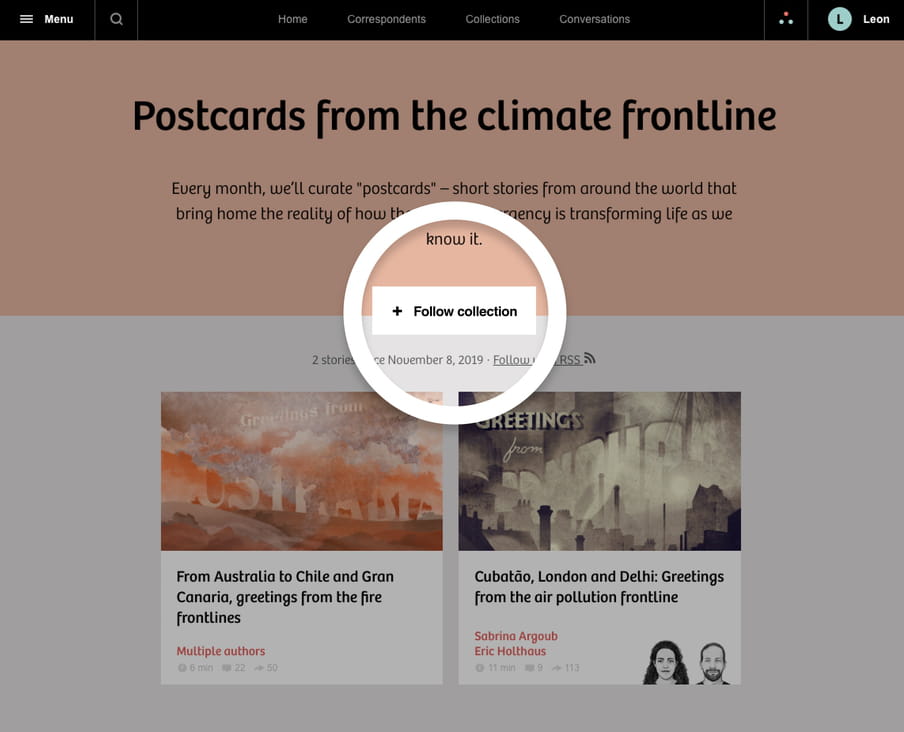When it comes to understanding foundational ideas about how our world works, one story is not enough. You can never know everything there is to know about a single topic without a range of perspectives. That’s why we’ll often publish multiple stories covering the different aspects and add it to a collection.
A collection is an easy way to cluster articles on the same topic. Here’s a rundown of why we use collections, and how you can get the most out of them.
What is a collection?
A collection is a body of work on a theme or topic. Each article can be understood alone, but reading the full collection gives you a deeper understanding of the topic and a broader view of the structural issues at play.
When you’re logged in, you’ll find the tab "collections" in the top menu. There you’ll find our journalism clustered according to theme, such as "Rethinking the news" or all our "Postcards from the climate frontline" .

Collections grow. Like anything, they start off small and as the topic develops – through correspondents following pointers from members or experts or guest writers digging deeper into questions – the body of work grows.
How you can use collections
To discover timeless pieces – and make them relevant again
The thing about publishing unbreaking news is that the relevance of stories isn’t determined by their timeliness. That’s to say that just because something was published today, it doesn’t mean it won’t be relevant a week, a year, or even several years in the future.
With some stories, their relevance even increases as more articles are added, more information is uncovered, or the very act of writing the piece triggers a constructive development in the world.
For example, back in November 2019, Economics correspondent Jesse Frederik wrote an article debunking the science behind online advertising, showing that the return on interest of online advertising is statistically indistinguishable from zero (in other words: online advertising doesn’t work as well as people think). As the US heads into another election – and indeed, countries go to the polls around the world – this story will continue to be relevant, as political advertising on social media will once again come under sharp surveillance.
To explore a theme more fully
As we’ve said, one story is not enough to cover an issue. That’s why we’ll often publish multiple stories covering the different aspects of the same issue in a single collection.

A story on how hotline responders deal with secondary trauma – as a result of speaking to people in high states of distress day in, day out – is interesting as a stand alone article, but you can get so much more from it by contextualising that one story within a bigger collection on trauma or guilt.
When you dive deeper into mental illness as a very human affliction, you no longer separate the two people at either end of the line in the article, but, in fact, understand better what unites them: we are all susceptible to trauma, whether it’s first-hand or something experienced through our empathy to others.
 Exploring guilt
Guilt is a feeling we all relate to, but what is it and can it ever be positive?
Exploring guilt
Guilt is a feeling we all relate to, but what is it and can it ever be positive?
To follow the correspondents’ learning curve
The structural issues that our correspondents explore in each article don’t go away: they evolve – and we’ll cover the evolution. By encouraging correspondents to write about what they learn as they research their stories (what we call “share their learning curve”), members and other audiences can follow them on their journey. We never presume that a correspondent will still hold at the end of their learning curve the assumptions they had at the beginning, so we want you to know what that evolution has been.
The collection Humanising AI is a good example of this. When Numeracy correspondent Sanne Blauw covered the news of a court that found that a digital welfare programme built using AI was deemed to be violating human rights, it was a really interesting story. But it didn’t end there.
Sanne was pushed by a fellow correspondent to dig deeper into a more foundational question: is our expectation that AI should be unbiased realistic? What Sanne learnt by following this line of questioning was that it’s not as easy as determining what is “better” between humans and AI. We need to start having serious conversations about which decisions we’re happy to leave to algorithms and which we’re more comfortable keeping in the hands of humans.
Following her on this journey on this one topic was interesting in and of itself, but the rest of the collection gives this one piece even more depth and richness: you discover exactly why AI is biased (because the humans that create it are), how automation in and of itself is not necessarily a good thing, and even just learn what AI is in a really simple explainer. Every story as part of the correspondent’s learning curve expands your knowledge on a subject.
 Humanising AI
Artificial Intelligence is going to have a huge impact on our lives, so we need to understand it better. Sanne Blauw goes in search of the people and the processes behind AI.
Humanising AI
Artificial Intelligence is going to have a huge impact on our lives, so we need to understand it better. Sanne Blauw goes in search of the people and the processes behind AI.
How to follow a collection
So to make it easier to stay up to date on the topics that interest you most, you can follow a collection. To do so, simply head to the collection page at the top of your browser.
Once you’ve clicked in to the collection, you can follow it by clicking the “follow” tab at the top of the page under the title. This means you’ll get notified by email and on the platform every time a new story is added to that specific collection.

Our platform is never finished. We’ll of course keep adding more collections and work on their functionality. We are very curious to know what you think of the Collections feature, or if you have suggestions on how we might improve it. Please let us know in the contributions below! Suggestions on new collections are also welcome.



